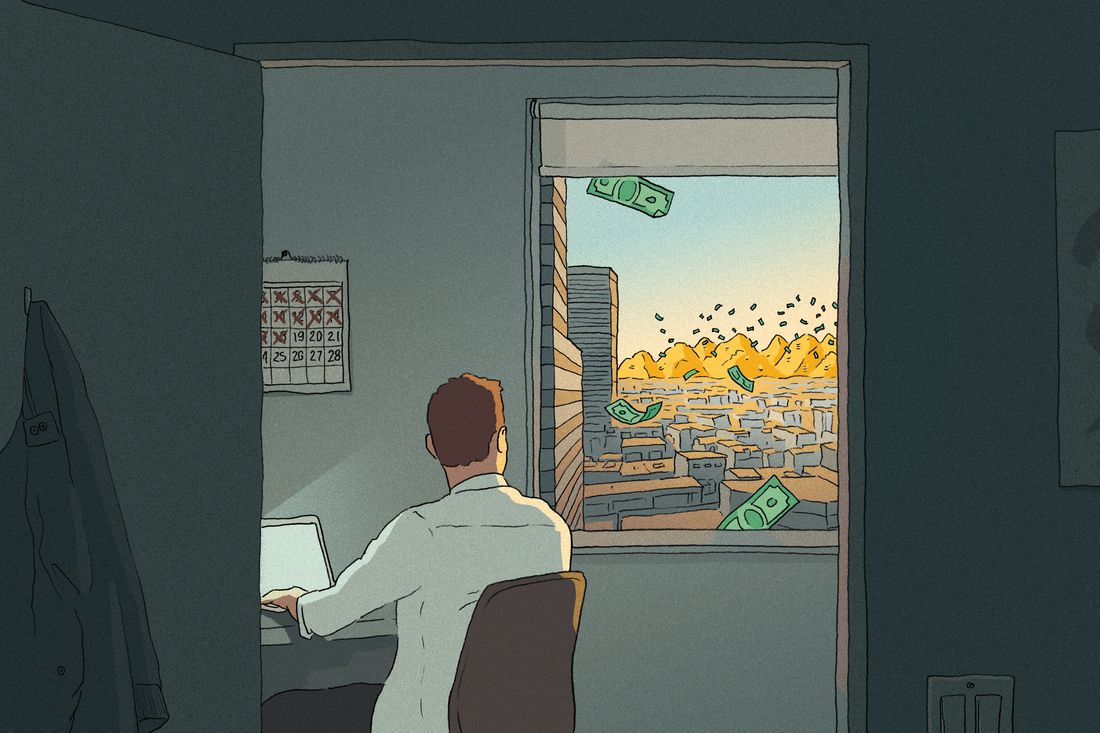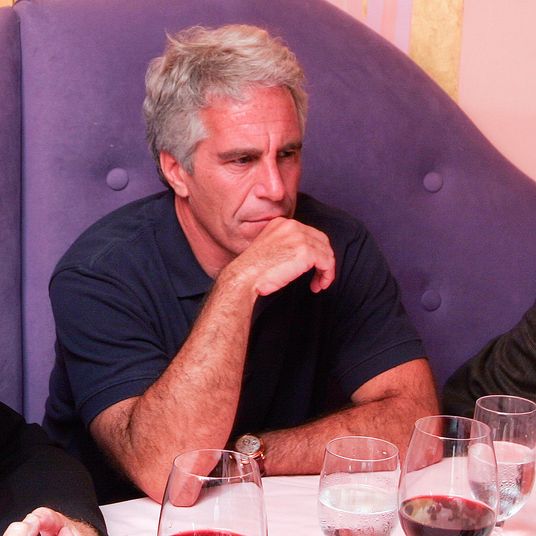
This article was featured in One Great Story, New York’s reading recommendation newsletter. Sign up here to get it nightly.
Sometime in the second half of the past decade, I decided to found a start-up. I was in my 20s and working at a mid-size tech company, and I didn’t yet have an idea, or even a general sense of where I wanted to focus. But I was convinced becoming a founder was the right thing to do next.
In college, I had majored in a discipline within the liberal arts. I would have liked to become a philosopher or a writer but lacked the intestinal fortitude to risk being poor, a perpetual worry in spite of — or because of — having enjoyed a solid upper-middle-class upbringing. My desire to be a capitalist may have crystallized a few years after graduation, when I attended a reading by a former professor, a lecturer from my alma mater, on tour for his new book. Seeing me in the audience, he invited me to a sumptuous dinner with several eminent literary types: an award-winning author, the proprietor of a cherished bookstore, a leading critic. We spent a great evening gossiping about famous writers, but when the check arrived, no one moved. Instead, we all made a furtive scan of the table — me, young with a tech job; them, decades older but sheltered from being first to reach for the bill by their commitment to art — realizing after an extended pause that no obviously rich person was around to pick up the tab. (We split it.)
I had always envied the gentry of the Enlightenment, who produced intellectual and artistic breakthroughs because they were smart but also because few others had the leisure to think. I also envied their modern equivalents, people with family money. What if I could make my own family money? That way, I could consummate my intellectual ambitions without sacrificing a reasonably bougie standard of living.
I began lurking in Reddit forums with names like “FATFire,” filled with people who obsessed over their “number”: the amount of money they wanted to sock away before they could pursue their whims forever. I remember hunching over a spreadsheet in a coffee shop one sunny weekend while my friends were at the beach, adding up the present value of my projected lifetime expenditures to estimate my own number. Of course, I had to factor in a safe withdrawal rate from my nest egg, private school for my hypothetical kids, and allowances like the occasional Michelin dinner. Around $6 million, I thought, ought to do it.
A strategy consists of matching means to an end; if my end was rapid financial independence, my means were youth, pedigree, lack of student debt, a prodigious capacity for work, and a lack of a faculty for combinatorics, which rendered me unsuitable for quantitative finance. It helped that I genuinely liked technology, had devoured science fiction and messed around with computers since I was little. The smart move was probably working for one of the FAANGs, which grew so reliably that you could chill and make a few hundred thousand dollars a year. But I didn’t want to do that. This was the mid-2010s. Though peak mania had yet to arrive, venture capitalists were showering people the same age as me with capital. Someone in my graduating class had just flipped a two year old start-up for a life-changing sum.
After several false starts, I was introduced to my co-founder by a mutual friend. He was affably bright in a way that balanced my neurotic tendencies, and I liked him right away. We had been exploring similar markets and started tinkering together on a promising idea: an outwardly boring but vast corner of a broader sector that was hot at the time. We fleshed out the idea over a series of whiteboard sessions at a WeWork, each followed by a trip to a dive bar where we’d get drunk and talk about our goals, speedrunning the process of becoming friends. We both agreed that we wanted money but not a lot. “What’s your number?” I asked.
“If we each made a few million,” he said, “that would be enough.”
Every founder tells themselves a story about why they’re heading to the gold rush, but the executive coach I would eventually hire says there are really only two. Do you want to be rich, generating wealth in service of some further end? Or do you want to be king, with money a mere byproduct of trying to make the world the way you feel it should be?
At the time, I told myself I wanted the freedom of being rich. I thought I’d be able to recognize a winning hand fast or fold. Now, several years later, I’m still waiting for the river card that determines my fate. You could call me a middle-class founder: proprietor of a business you may or may not have heard of, tenuously wealthy on paper, by no means a failure but not yet a success, chugging along in the twilight of an era that minted more giants and more waste than any other in history, with no exit in sight.
Fans of Paul Graham — founder of Y Combinator, the leading start-up incubator in the land and one of the patron saints of the modern start-up era — would probably say my original sin was being a mercenary. For about a decade, starting when the first tech bubble popped in the early 2000s and ending with Facebook’s IPO in 2012, founding a start-up just to make money was both crass and unwise. If a founder wanted to raise money or hire the best people, the dogma went, it was important they lay claim to changing the world. Organize the world’s information (Google), bring the world closer together (Facebook), belong anywhere (Airbnb): The ideal founder was the protagonist of a Zen koan, or Harry Potter facing the desire mirror in The Sorcerer’s Stone. Seek money, find nothing — but seek the voice of the customer, and find the riches you never wanted but are darn glad to have.
The extent to which founders really followed this precept is debatable. But in the early 2010s, three things happened to make start-ups more attractive to mercenaries looking for a lucrative exit. Finance became less cool and generally less profitable after 2008. Several start-ups of the past decade, led by Facebook, grew into robust and outrageously profitable behemoths. And interest rates came down to zero, creating a glut of money seeking returns and increasing the spreadsheet value of profits generated far in the future (which happen to be the only profits most start-ups generate). This potent combination spawned an avalanche of capital earmarked for start-ups and doled out by venture capitalists. Over the coming years, a portion of these venture dollars wound their way to genuinely innovative companies. Some of it landed in money pits like WeWork. Far too much was airdropped into the Ponzi-ridden wasteland of crypto. And a tiny sliver landed with me.
Before I met my co-founder, I spent a year trying to identify business opportunities that were both personally compelling and commercially viable. When I pitched my VC friends these ideas — for example, a niche media company — they were kind but unimpressed.
“What about addressable market?” my friend T asked over dinner. Translation: If you succeed, how much money could this make us? He was delighted I was pitching him so we could charge our meal to his firm, a prominent bank that had entered the VC game but retained its relatively stingy expense policy. “This could be a big business!” I said.
“My guy, I think we have different definitions of big,” he responded. Venture capitalists, I’d soon learn, don’t get out of bed unless a start-up has the potential to generate roughly a hundred million dollars of revenue per year. This implies the company is worth some multiple of that number, which in turn enables the average investor to “return the fund,” or generate a sum of returns equivalent to the whole pot of money they have to invest, if the company is bought or goes public. I had been introduced to the tyranny of the power law: the need for winners to win big because most start-ups fail.
I could have tried roughing it without venture funding, what the industry calls “bootstrapping.” The venture world has a condescending label for bootstrapped companies without scale potential: a “lifestyle” business, which roughly translates to: Good for you, now back to the sandbox until you’re ready to play with the big boys. Given my professed aim, this could have made sense. But there was so much funding for the taking, and part of me figured that if I was swinging, I may as well swing big. Why not make more than $6 million? So I narrowed my focus to the beam of a management consultant, scanning for hallmarks of a “venture-scale” business: addressable market, gross margins, incumbent NPS, lifetime value. You can Google these terms if you’d like, but taken in aggregate, all they mean is dollar signs.
As I talked through our idea with my co-founder, I ran through the VC-ratified checklist in my head: Large market — check. Fragmented landscape with dissatisfied customers — check. Most businesses are interesting if you look at them closely enough, but the perception of boringness — workflow automation, human-resource information systems — is good because competition is death; the cooler you sound at parties, the harder it is to succeed. The idea was far from perfect, but I was impatient, and after a rapid courtship, we decided to try raising a round of funding. If we could pull together enough to get started — a sum I estimated in the mid-six figures — we’d quit our jobs and found the company. I made a PowerPoint, following a handy template produced by Y Combinator: problem, solution, how you find customers, all vagaries eliminated.
We received plenty of rejections. These surprised us, though a state of the world enabling two people who barely know each other to obtain hundreds of thousands of dollars with nothing but a few dozen prettily formatted words should have been far more astonishing. Some part of me was relieved by the rejections, which might have built slowly toward permission to throw in the towel, until we got our first yes — on the basis of a single phone call with an investor about the same age as me.
“What could go wrong?” he asked.
“Well, a lot,” I said, and I laid out the ways our thesis might be flawed, along with a theoretical solution to each snag. I treated this as a game, like switching to the affirmative after arguing the negative in a high-school debate, but he seemed convinced of something.
“Have you incorporated?” he asked.
When he emailed to say he was inclined to invest, I wondered what he had learned over the course of a half-hour to make him write this check. It was an astounding hourly rate. Later, I learned that he was rich and wrote many checks and that this check, in the grand scheme of this world, was small. After the first year, I never heard from him again. He’s still on our cap table today, making money while he sleeps.
We used the momentum from his “yes” to secure others, then incorporated our business using a tool created by a company called Stripe to make it easier for entrepreneurs to form corporations. As I typed our company name into the web form, I recalled that when my father started a small company decades ago, he had to write a physical letter to a legal agent in Delaware. I wondered briefly if there should be more friction in making a decision to start a company. To some extent, reducing friction is what the whole start-up game is about: Calling a cab when you want it, summoning food when you want it, an infinite radio that plays whatever you want on command. I clicked the button, submitted the form, and incorporated.
We hired a small team. Because we couldn’t afford to pay top dollar, we looked beyond the world of Ivy League, Big Tech, and management-consulting alumni to find moneyball hires mispriced by the market. The best of them were searching for a chance to prove their worth, and we gave it to them. The first year or so was a constant swing between the radiant high of making customers happy and the comedown of watching our jerry-rigged product disappoint them. I learned most customers are indifferent as long as the job gets done, about 20 percent are discerning but reasonable, and 3 percent will drive you nuts (no amount of support will satisfy them because the product they really need is therapy).
Buried in my master plan was an assumption that I could stay above the emotional fray of building a company. In hindsight, this was dumb. Start-ups are like sharks: They need movement to survive. But movement implies change, change implies volatility, and volatility implies fluctuations between good and bad. To succeed, you need to average more good days than bad, but bad days are impossible to avoid. And more than any other trait, good founders are defined by an obsession with doing things right; it was inevitable that my self-worth would become entangled with the performance of the business.
This felt great during the good times. Over the coming years, the company grew. At parties, where I had assiduously avoided the “What do you do?” question for years and responded when asked with a self-effacing bit on the mundanity of our market, people I didn’t know started to recognize our start-up. Some even used and liked the product.
But it didn’t feel as good when I looked around. In 2021, COVID and its aftermath marked peak froth for tech. The phenomenon of SPACs gave questionable but sexy companies a shortcut to going public. Crypto had reached full sail. Other founders I knew were raising absurd amounts of money for concepts that made a napkin business plan look fleshed out, spurred by a new class of leviathan VCs that had raised mind-bogglingly large funds. Founders could sell their own stock to these investors, sometimes pocketing more millions personally than their companies had earned in lifetime revenue. I still hadn’t made a cent beyond the salary I paid myself.
I’d like to say we never considered taking this money, but we did try pitching a megafund partner during our last round of fundraising in the latter days of this madness. We told the story of our business, and he cut us off after 20 minutes with a curt, “You can clearly execute, but this won’t get big enough for us.” Market sentiment had turned against our particular vertical; it felt like we were sprinting to stay in place. Meanwhile, start-ups that had staked a claim on vast frontiers of innovation — immutable money, infinite frontier, and eternal life, as the Twitter bio of a prominent crypto evangelist proclaimed — were speeding on a moving walkway toward giant valuations and general adulation.
The mood inside our company all-hands during this time was confusing. We were growing sustainably, making even our pickiest customers happy, but it was a euphoric time in the world outside our Zoom screens; you might be having fun sober at the party, but it’s hard not to watch your friends on drugs and wonder what it’s like. The irony that selling fiction to investors was making these founders richer than selling a bona fide product to paying customers wasn’t lost on me. But it wasn’t just the money: After years of work, I had the temerity to be proud of the culture and product we had built. I had started to believe we could actually make a difference. In the market of 2021, our mission felt quaint; we may as well have been a lifestyle business.
At the tippy-top of the market, a party. I met another founder, a few years older than me, who had unequivocally made it, with a liquid net worth of multiples of my number. I was tipsy enough to ask all kinds of direct questions about what it was like. He was tipsy enough to answer unequivocally: Yes, having a fuck ton of money is great.
This is the difference between equity and cash: Partying in prime time in Aspen and Cannes; a gorgeous apartment in one of the best neighborhoods in our city, which I saw when he brought the after-party there; other apartments around the country and in a premier European capital where he lived a month or two out of the year. Meetings with anyone you want, whenever you want. Respect among both the tech cognoscenti and normal people who figured out what he had made. I knew this because of the deferential way I behaved around him.
“What gets worse?” I asked.
“You can probably guess,” he said. It was what you expect: People treat you less like a human and more like a mythical being or a piggy bank.
“Do you want more?” I asked.
I don’t remember his answer; things were hazy by this point. I staggered out of the fifth bar we visited that night, more intoxicated by the conversation than the drinks, just sober enough to be perturbed by my own fascination. Financially, my best-case outcome was a fraction of what this guy had already. No one needed the amount of money he had: an amount of wealth impossible to justify by any rational calculation of needs I could run on a spreadsheet (which explains why he was spending it on frivolous things). But now my number seemed too low. That night, I dreamt about market size, which in my subconscious manifested as a visual resembling the spirals of light that appear when you press directly on your eyeballs, rippling wider and wider. I woke up stressed.
Today, the market has turned for everyone. We’re growing slower than I want, but other start-ups, even the hot companies that dominated fundraising in past years, are showing far more signs of strain. Some have already flamed out spectacularly, and for those that survive, the gobs of money raised from megafunds come with a catch: It needs to be paid back first, which means that employees and early investors who expected millions won’t make any money unless they deliver on their tall tales.
The culprit is technically rising interest rates, but you could argue it began when founders and investors started to see the downside of swinging for the power law. The first venture funds formed as a way for savvy investors to help innovators create fundamental technologies like transistors, which required huge outlays of time and treasure before they could produce value. But in the past few years, causality inverted: Start-ups and entire markets were manufactured from whole cloth to meet the demand of overcapitalized venture funds searching for a home run.
Exit markets have dried up. I have yet to hit my number, though I’d guess my odds of getting there in the next couple years are decent. I would be disappointed if it didn’t happen, but I’m not sure it would change what I do next. At work, there’s some sense that we’ve missed the windfall, the easy IPO, the fairy godmother of acquisition that taps some lucky people and makes them rich. You’d think that would suck for morale. But from what I can tell, our team seems happy. What venture capitalists are now telling startups to do — forget “growth at all costs”, be profitable — is what we, partly by accident, have been doing all along. With the exception of the new wave of AI companies, the skies are full of Icaruses crashing to earth, but we’ve been here the whole time.





























